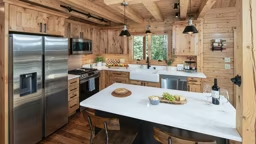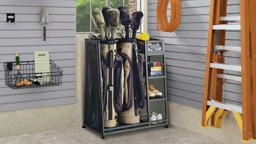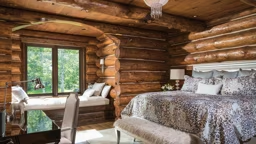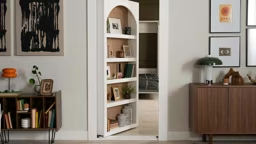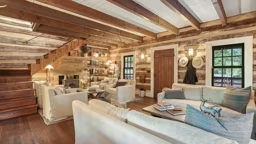
Photo: Rich Frutchey / Hearthstone Homes
Since the earliest days of humankind, we’ve gathered around a fire for warmth, protection, food preparation and community. And while we no longer rely on an open flame for cooking or heat, there’s still something about fire that draws us to it. Fire is primal; it’s mesmerizing; it’s comforting.
So it’s no wonder that from New York to New Mexico, fireplaces are seen as essential log and timber home features no matter the climate. They ground a space, anchoring a home to the earth. But the great room isn’t the only spot in the house that may benefit from a little firepower. While planning your home, consider all the areas where the flicker of the flame and the glow of the embers could warm your heart (as well as your toes).
Smart Positioning
In addition to aesthetics, there are other reasons fireplaces are most frequently located in the great room. In the vast majority of floor plans, the great room is flanked by bedrooms, home offices and the like, so if the intent is to provide a heat source as well as a focal point, placing it in the middle of the plan makes sense. However, wood-burning fireplaces and chimneys can be massive, so they’re typically installed in a chase protruding outside the home in an effort to conserve livable space inside. Instead of serving as a viable supplementary heat source, this placement could cause unwanted air infiltration. Why?
A fireplace relies on the buoyancy of its hot exhaust for combustion and airflow up the chimney, but when the chimney is on the exterior of the house, its ability to resist the negative pressure inside the house is weakened. So placing it on an exterior wall in the great room actually can bring cold air into the home when the fireplace isn’t in use.
To create radiant heat and keep it indoors, position your hearth in the center of the plan, containing all four of the chimney’s faces inside, and add a ceiling fan to circulate the warmed air throughout the room.
Another factor to consider is the impact the fireplace will have on your home’s roofline. Building codes typically require that a chimney rise a minimum of 3 feet above the highest point and at least 2 feet above any roof surface within 10 feet of it. Therefore, if the fireplace is on a sidewall where the roofline slopes down, a very tall chimney or stovepipe may be required. Again, placing the fireplace in the center of the home, where the ridgeline is typically the tallest, will enable you to reduce the height, improving the look and potentially saving you money on materials.
Additional Locations
A soaring great room fireplace will always be a popular feature in log and timber homes, but with the other, smaller hearth options out there — some requiring little to no ventilation — you have the flexibility to infuse a little firepower in unexpected places.
Kitchens.
Once upon a little house on the prairie, kitchen hearths were essential for cooking. Now, they’re rarely seen; but when properly configured, they can be a huge help (and a conversation piece) in a modern kitchen.
For starters, raise the firebox 3 feet off the floor if possible. This will keep the stress off your back when tending to the fire, and, when seated at a kitchen table, it will place the blaze at eye level for everyone to enjoy.
Make sure the firebox opening is large enough to actually cook over the flame, if you so desire. Install a swing arm to hang a pot or kettle, and consider a wood-fired oven on top of the firebox for authentic pizza nights.
Bedrooms/Bathrooms.
Installing a fireplace in a master bedroom or bathroom provides a spark of luxury, and for these locations, direct-vent gas models are the smart choice. These self-contained, sealed units are vented through the nearest exterior wall, so they don’t require chimneys, nor do they need structural reinforcement to carry their weight the way masonry hearths do. (Plus, who wants to lug firewood and deal with the mess from embers created by a wood-burning fireplace in and out of the master suite?)
Of course a gas unit requires a gas or propane line to operate. If that’s not possible where you live but you still want the ambiance, an electric unit can be a great choice. Today’s electric models have surprisingly realistic flames and even throw off a fair amount of heat.
As for placement, raise the unit up from the floor a few feet so that you can see the hearth while lying in bed or relaxing in a warm bath. To economize, consider installing a two- or even three-sided unit on the wall that divides the master bedroom and bath so you can enjoy the fire from both spaces — a two-for-one bargain!
Home Offices.
With more people permanently working remotely, why not make your home office a place you’ll really enjoy? Adding a small fireplace, whether it’s wood burning, gas or electric, will keep the space warm and cozy — literally and figuratively.
When deciding its location in the room, first consider where your desk will be. If you want the maximum viewpoint and radiant heat benefits (and your floor plan permits), place the hearth directly across from the desk. Or, if you prefer, place the unit in a corner near a built in bookcase and add an overstuffed armchair to create a reading nook. Adding a secondary workspace such as this will encourage you to get up from your desk now and then, which mental health experts say you should do for at least five minutes every hour to increase productivity and improve your overall mood.
Outdoors.
Over the years, outdoor fireplaces have surged in popularity, from full-on masonry hearths to portable patio chimineas. Just as they do indoors, masonry fireplaces require a hefty concrete foundation and reinforcements, while a portable unit needs nothing more than a fireproof base to place it on.
If your outdoor hearth will sit on a wood deck, you may need to provide a fire-safe zone in front of the opening to prevent flying embers from scorching or burning the decking. To keep smoke from drafting back into the seating area, ensure the chimney is high enough to exhaust the smoke and gases up and away from the crowd.
Regardless of location, every home can benefit from having a fireplace or two. Be sure to carefully weigh your options against how you plan to use the fireplace, as well as your budget, and ask both your designer and builder for advice. As a team, you’ll find the perfect unit that will get you fired up about life in your log or timber home.




